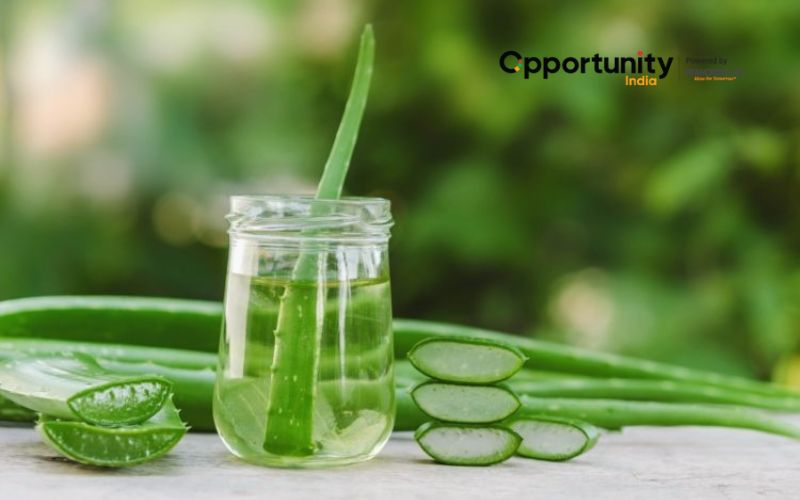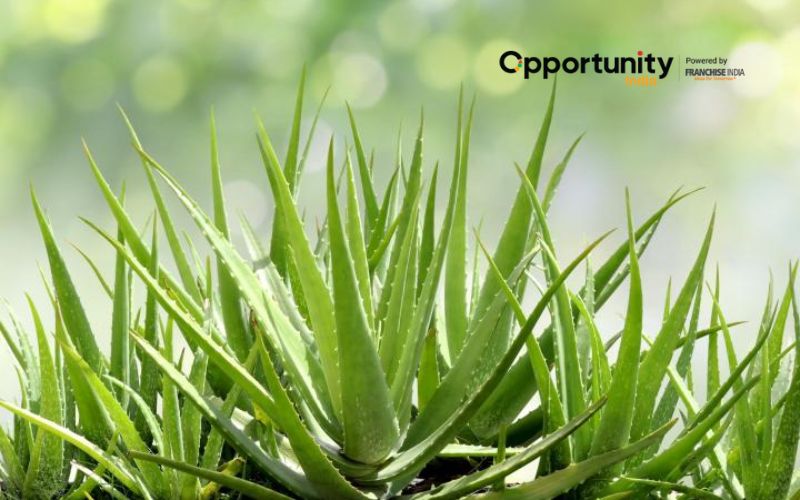
Traditional farming is not easy, given unstable weather and growing land expenses. However, what if there were a crop that thrives in unfavorable soil, requires little water? You might be amazed to know, it is highly popular in markets for wellness and beauty products. Yes, we are referring to aloe vera, the miraculous plant that everyone's grandmother uses religiously! If you've been thinking about starting a farming business, aloe vera could be your green luck. From the fundamentals to creating a strong business plan, let's explore how to begin aloe vera farming in India.
Aloe Vera Farming in India: A Lucrative Green Venture
The "wonder plant," aloe vera, has evolved from its traditional garden cure to become a major commercial crop in India. Aloe Vera farming is becoming a more alluring and profitable endeavor due to its numerous uses in the food, cosmetic, and pharmaceutical sectors, which have stimulated a growing market.
The size of the worldwide aloe vera market was USD 890 million in 2024. It is projected to grow at a compound annual growth rate (CAGR) of 6.3% from 2025 to 2033 to reach USD 1530 million. Aloe Vera has become well-known due to the increased demand for natural and organic products globally. Aloe Vera and its products have a thriving domestic market in India because of the country's strong Ayurvedic legacy and growing health and wellness consciousness. This drought-tolerant, low-maintenance crop provides significant returns, making it a perfect option for agricultural diversification.
Also Read: How to Start Organic Farming: Profitable Business Plan?
The aloe vera market in India grew from USD 29.1 million in 2024 to USD 50.5 million by 2033 at a compound annual growth rate (CAGR) of 6.30%. The ancient Egyptians referred to aloe vera as the "plant of immortality," and it has since transformed into a beautiful treasure trove for Indian farmers. Aloe vera farming is now an economic prospect rather than merely a home treatment due to its growing demand in the food, cosmetic, and pharmaceutical industries. Aloe vera may be your best option if you're searching for a crop that requires little care and yields a lot of benefits.

Why Choose Aloe Vera Farming?
- High Market Demand: Aloe Vera is a staple in many items, such as medications, beverages, gels, creams, lotions, and shampoos. The culinary, cosmetic, and pharmaceutical industries are continuously increasing their demand.
- Low Maintenance: Aloe Vera uses less water, fertilizer, and pesticides than many other crops, which lowers input expenses.
- Drought Tolerant: It can be grown in places with little water supply because it does well in arid and semi-arid climates.
- Perennial Crop: Aloe Vera can produce for three to five years after planting, offering a steady source of revenue without the need for yearly replanting.
- High Profitability: Growing aloe vera can yield substantial revenues per acre when managed properly.
Step-by-Step Guide to Start Aloe Vera Farming
Soil and Climate Requirements
- Climate: Warm, dry areas are ideal for aloe vera growth. Temperatures between 25°C and 40°C are ideal. Although it can withstand a lot of drought, it cannot withstand severe frost or flooding.
- Soil: The ideal soils are light soils with a pH of 7.0 to 8.5 or well-drained sandy loam. Soils that are heavy in clay should be avoided.
Preparing the Land
Only 20 to 30 cm of the aloe vera's root system reaches deep into the ground.
- Plowing: Plough the ground one or two times before leveling it to attain a beautiful tilth. Maintain enough drainage to prevent stagnant water.
- Manuring: During the final plowing, add 10–15 tonnes of well-decomposed Farm Yard Manure (FYM) or compost per hectare (about 6 tonnes per acre) to improve the fertility of the soil.
- Formation of Ridges and Furrows: Make ridges and furrows that are 45–60 cm apart.
Also Read: How To Start a Fish Farming Business With a Plan in India?
Planting Material and Sowing
- Suckers: These are immature shoots that sprout from the parent plant's base. Select healthy suckers that are three to four months old, 20 to 25 cm long, and have four to five leaves.
- Cuttings of Rhizomes: Once the crop has been harvested, the underground rhizomes can be excavated and divided into 5–6 cm segments, making sure that each segment has a minimum of two to three nodes. Before being transplanted, these can be rooted in sand beds.

Irrigation and Fertilization
Despite being a low-water crop, aloe vera requires careful nutrient management and irrigation to produce at its best.
- Irrigation: Water the field right after planting. Although aloe vera is typically irrigated during dry spells, particularly in the summer (every 15 days) and winter (every 30 days), it requires additional irrigation. Steer clear of excessive watering as this can cause root rot.
- Fertilization: When preparing the land, apply a base dose of NPK (nitrogen, phosphorus, and potassium) at a rate of 20:20:20 kg/acre in addition to the FYM. Once the plants are established, the remaining nitrogen can be added. It is often advised to apply 150 kg of NPK mixture per acre.
Weed Control and Pest/Disease Management
- Weed Control: Make sure the field is free of weeds, particularly in the early stages of growth. Each year, two to three hand weedings are followed by light hoeing to encourage suckering and development. Within a month of planting, the first weeding should be completed.
- Disease and Pest Control: Aloe Vera has a relatively high resistance to illnesses and pests. However, some fungal patches and root rot from waterlogging are regular problems. To avoid root rot, make sure the drainage is adequate. Remove any affected leaves and, if required, use fungicides to treat fungal spots. For the preservation of the plant's inherent qualities, organic pest control methods are recommended.
Harvesting and Management After Harvest
- Harvesting Time: Nine to eighteen months after planting, when the outer leaves are mature, thick, and juicy (60 to 80 cm long and 8 to 10 cm wide), aloe vera is usually ready for its first harvest.
- Technique: Carefully remove or trim the older, outer leaves from the base of the plant without causing any harm to the main growth. Regeneration is made possible by this. The ideal times to harvest are in the morning or evening.
- Frequency: With the right management, a single plantation can provide two to three harvests a year for up to five years. Usually, each plant produces three to four leaves per harvest.
- Post-Harvest Care: Since harvested leaves are consumable, they need to be handled with caution to avoid microbial contamination and damage.
Also Read: How To Set Up an AgriTech Business?
Marketing and Sales Strategies
Securing buyers before or immediately after cultivation is crucial for success.
- Local Markets: Offer fresh leaves for sale to individual customers, small-scale juice shops, or nearby Ayurvedic practitioners.
- Wholesale Mandis: Get in touch with major agricultural marketplaces' wholesale vendors of medicinal plants.
- Online B2B Platforms: To reach bigger buyers, list your product on business directories and B2B websites such as Alibaba India, IndiaMART, etc.
- Adding Value: Think of turning aloe vera leaves into main items such as:
- The most popular type, aloe vera gel, is utilized in medications and cosmetics.
- Aloe Vera juice is a well-liked health beverage.
- Aloe Vera powder is utilized in a variety of recipes.
Although it takes more money, setting up a modest processing plant can greatly boost profitability.
Aloe Vera Farming in India: Initial Investment Breakdown
| Activity | Cost (INR) |
|---|---|
| Land Preparation | ₹5,000 |
| Suckers (15,000 @ ₹1 each) | ₹15,000 |
| Organic Manure | ₹3,000 |
| Irrigation Setup | ₹8,000 |
| Labor (planting, weeding) | ₹10,000 |
| Miscellaneous (tools, fencing, transport) | ₹5,000 |
| Total Initial Investment | ₹46,000 |
Also Read: How to Start a Button Mushroom Farming Business?
Growing aloe vera in India has a lot of potential. It is a business that meets all the requirements for sustainability, profitability, and scalability—it requires little maintenance, has a robust market, and requires little investment. Aloe vera is a wise crop to think about if you're a new farmer or business owner searching for your next green endeavor. Starting a business in this field may require you to carefully understand your market, maintain quality, and investigate value-added items.

